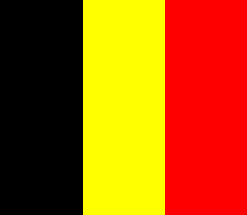 |
 |
2017 |
Donderdag 30 november 2017
We take the metro to the Central Station of Rotterdam. On arrival there it
starts to rain. We are waiting on track 3 for the Thalys to Antwerp (with final
destination Lille Europe). At 7:57am the train departs on time and bolts at
300km / h to Antwerp, where we arrive half an hour later. We take the tram to
the centre.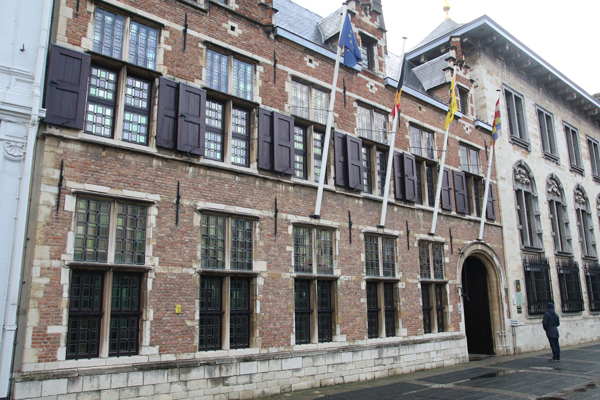 We alight a few stops too early and we have to walk a little longer to the Bed &
Breakfast Le Prince d'Anvers of Frederique on Grote Godaard. The street is
undergoing construction work and we have to make our way along the fences and
deep pits to get to the front door. We leave the suitcase behind and look around
in the Prince’s Room on the first floor. We go and have coffee with cake at Normo,
a trendy coffee shop at the Minnebroedersrui. Then we walk to the Grote Markt to
buy a 48 hours Antwerp City Card.
At €35 this card entitles to unlimited travel by tram and bus and access to many
museums in the city. We walk with help of the map to the
Rubens House on a
side street of the busy shopping street Meir, called Wapper. The façade of the
Rubens House is being renovated and the building is in scaffolding. At the cash
desk we receive an entrance ticket on presentation of our Antwerp Card and
follow the self guided tour through the house. Rubens (1577-1640) was a very
successful painter in 16th and 17th century Antwerp. At his peak, he had a
studio with three workplaces inside the Rubens House, where he moved in in
We alight a few stops too early and we have to walk a little longer to the Bed &
Breakfast Le Prince d'Anvers of Frederique on Grote Godaard. The street is
undergoing construction work and we have to make our way along the fences and
deep pits to get to the front door. We leave the suitcase behind and look around
in the Prince’s Room on the first floor. We go and have coffee with cake at Normo,
a trendy coffee shop at the Minnebroedersrui. Then we walk to the Grote Markt to
buy a 48 hours Antwerp City Card.
At €35 this card entitles to unlimited travel by tram and bus and access to many
museums in the city. We walk with help of the map to the
Rubens House on a
side street of the busy shopping street Meir, called Wapper. The façade of the
Rubens House is being renovated and the building is in scaffolding. At the cash
desk we receive an entrance ticket on presentation of our Antwerp Card and
follow the self guided tour through the house. Rubens (1577-1640) was a very
successful painter in 16th and 17th century Antwerp. At his peak, he had a
studio with three workplaces inside the Rubens House, where he moved in in
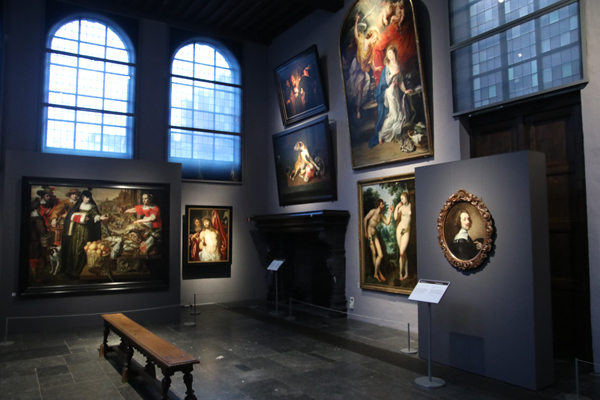 1610.
He had numerous employees and apprentices, including Anthony van Dyck and Jan
Brueghel. There are many copies of Rubens's work in the Rubens House, as well as
a few orignals. Also works of contemporaries who belonged to Rubens's own
collection. Well-known real Rubens works that are displayed here are Adam and
Eve from his early period, a self-portrait and the Annunciation.
1610.
He had numerous employees and apprentices, including Anthony van Dyck and Jan
Brueghel. There are many copies of Rubens's work in the Rubens House, as well as
a few orignals. Also works of contemporaries who belonged to Rubens's own
collection. Well-known real Rubens works that are displayed here are Adam and
Eve from his early period, a self-portrait and the Annunciation.
After the Rubens House we walk towards the
Plantin-Moretushuis.
On the way we stop at Lints, a large pastry
bakery and tea room. We continue our way and arrive at the Vrijdagmarkt at the
Plantin-Moretushuis. Christoffel Plantin was a French bookbinder, who in 1555 in
Antwerp, because of physical injury, switched to the printing business. Together
with his son-in-law Moretus, he established a printing house that would become
the most important in the city. Plantin prints for Catholics, Protestants and
humanists such as Justus Lipsius and Simon Stevin. H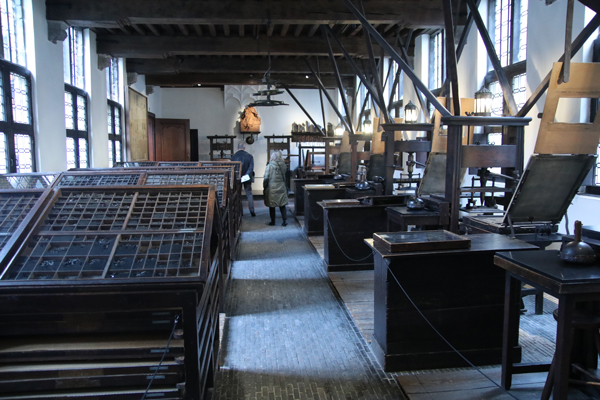 e
was the only printer of Missals and Breviaries in the countries that came under
the Spanish king. In 1568 the Biblia Regia (in 8 volumes) was printed here and
in 1573 the Glossary of Low German Languages, the first Dutch dictionary. The
printing house remained for many generations in the Moretus family but had to
close in 1866. In 1876 it became a museum. Upon arrival, the employee who only
needs to provide us with the guide book starts an extensive introduction about
the creation of the printing house. After his exposé, we explore the rooms on
two floors on our own. Many books from the printing house can be seen - Bibles,
missals, atlases, dictionaries etc), portraits of the family and a room with
authentic printing presses. The walls are usually covered with printed leather.
e
was the only printer of Missals and Breviaries in the countries that came under
the Spanish king. In 1568 the Biblia Regia (in 8 volumes) was printed here and
in 1573 the Glossary of Low German Languages, the first Dutch dictionary. The
printing house remained for many generations in the Moretus family but had to
close in 1866. In 1876 it became a museum. Upon arrival, the employee who only
needs to provide us with the guide book starts an extensive introduction about
the creation of the printing house. After his exposé, we explore the rooms on
two floors on our own. Many books from the printing house can be seen - Bibles,
missals, atlases, dictionaries etc), portraits of the family and a room with
authentic printing presses. The walls are usually covered with printed leather.
After this museum we have lunch at Le Pain Quotidien at the Steenhouwersvest. A soup and sandwich of the day. After lunch we return to the B & B and rest.
In the afternoon we take the tram line 7 to the Eilandje (little island).
This is a port area on the north side of the city. It was incorporated into
the city in the first half of the 16th century as a port area and was called
Nieuwstad (new town). As a port area it went downhill in the 20th century,
until it was redeveloped into a residential area and a recreational area,
around the turn of the century. In the middle of it is the
Museum aan de Stroom (MAS), a spectacular
design by the Rotterdam architects Neutelings and Riedijk from 2011. We have
already been there and we walk on to the buildings of
Red Star Line.
This shipping company, officially called Société Anonyme de Navigation
Belge-Américaine, was a passenger and freight line, which operated a regular
service between Antwerp and New York and sometimes also Philadelphia. The
company started in 1872 and went bankrupt in 1935 and was taken over by
their old rival from Rotterdam, the Holland-America line. Goods were
transported from the US to Antwerp and persons on the way back. Some 2
million migrants from Belgium, but also other European countries exchanged their
poverty in Europe for a new start in America. The line also had famous
passengers, like Albert Einstein. In the museum the history of the line is
outlined, but also the process that the emigrants had to go through to get
on board. They were washed and disinfected and then extensively examined
medically. Initially in the open air on the quay, but after complaints from
the travellers in a separate building. It is an attractive exhibition with
witness reports, documents, film images and photographs and scale models. On
top of the building a watchtower was built, from where we could have
beautiful views over the port of Antwerp. Unfortunately, the weather has
deteriorated significantly. There is sleat falling down on us.
migrants from Belgium, but also other European countries exchanged their
poverty in Europe for a new start in America. The line also had famous
passengers, like Albert Einstein. In the museum the history of the line is
outlined, but also the process that the emigrants had to go through to get
on board. They were washed and disinfected and then extensively examined
medically. Initially in the open air on the quay, but after complaints from
the travellers in a separate building. It is an attractive exhibition with
witness reports, documents, film images and photographs and scale models. On
top of the building a watchtower was built, from where we could have
beautiful views over the port of Antwerp. Unfortunately, the weather has
deteriorated significantly. There is sleat falling down on us.
We walk back to the tram and ride it to the B & B. Around half past seven we take tram line 4 to restaurant The Jane (2 Michelin stars), by the Dutch star chef Sergio Hermans. The Jane is located in the chapel of the former Military Hospital in 't Groen Kwartier district in Berchem. It is about half an hour away by tram. A beautiful restaurant has been created in the chapel. The kitchen is where the altar and choir used to be. From the ceiling a gigantic chandelier is suspended with dozens of lamps at the end of long poles. We are warmly welcomed and after Jane's own champagne we start a 12-course dinner, accompanied by the Essentials wine arrangement of relatively new but beautiful wines. It is a pleasure. Almost four hours later, a taxi takes us back to the B & B in the old centre.
Weather: rain and sleat. 6 degrees
Friday, December 1, 2017
Frederique serves us breakfast in the room. Everything is there, except
meats and it tastes fine. Afterwards we drink coffee at Norma,
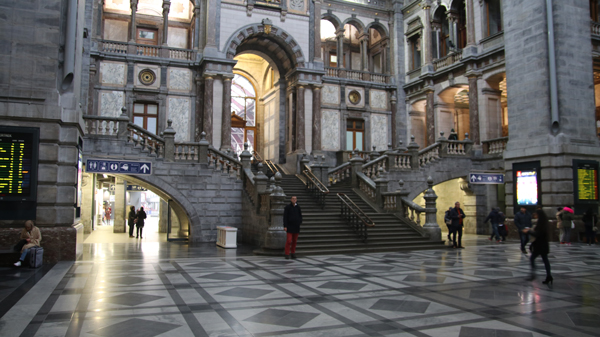 after
which we take tram 12 to the central station. We agreed to meet here with
Erwin Liekens, our guide, which we found through
Tours by Locals. He will
be guiding us for the next three hours through some lesser-known parts of
the city. We start in the beautiful railway station from 1905, which does a
lot to impress the arriving traveller. At that time it was outside the city
and a boulevard was built to the now no longer walled city. Antwerp
experienced an economic boom as a port city after the abolition of the toll
on the Westerschelde. You can see that. King Leopold II also put a penny in
the bag. From the station we walk into the diamond quarter. Antwerp has four
diamond exchanges and is the most important centre for diamond cutting and
trade in the world. The diamond trade is partly dominated by orthodox Jews.
Their appearance in the streets is almost the only indication of the trade
that takes place here.
after
which we take tram 12 to the central station. We agreed to meet here with
Erwin Liekens, our guide, which we found through
Tours by Locals. He will
be guiding us for the next three hours through some lesser-known parts of
the city. We start in the beautiful railway station from 1905, which does a
lot to impress the arriving traveller. At that time it was outside the city
and a boulevard was built to the now no longer walled city. Antwerp
experienced an economic boom as a port city after the abolition of the toll
on the Westerschelde. You can see that. King Leopold II also put a penny in
the bag. From the station we walk into the diamond quarter. Antwerp has four
diamond exchanges and is the most important centre for diamond cutting and
trade in the world. The diamond trade is partly dominated by orthodox Jews.
Their appearance in the streets is almost the only indication of the trade
that takes place here.
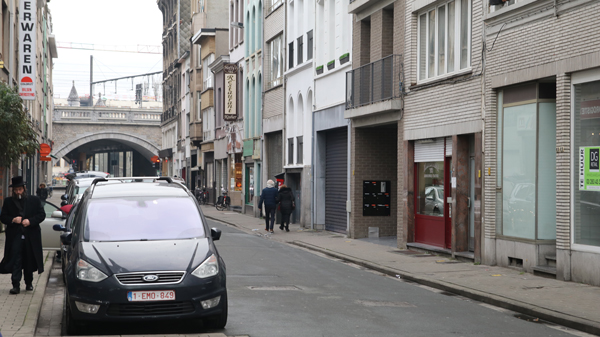 The
buildings in the diamond quarter are so bland, ugly and unremarkable that
you can hardly imagine that billions are being traded here, a few percent of
the Gross National Product of Belgium. Meanwhile, Indian and Pakistani
traders have also acquired a position on the Antwerp market. From the
diamond quarter we walk into the Jewish quarter along the railway viaduct.
That viaduct is also beautifully decorated with turrets and battlements.
Many of 20,000 Antwerp Jews are orthodox and ultra-orthodox and
traditionally dressed in black costume, long coat, top hat, beard and pipe
curls along the temples. In the district th
The
buildings in the diamond quarter are so bland, ugly and unremarkable that
you can hardly imagine that billions are being traded here, a few percent of
the Gross National Product of Belgium. Meanwhile, Indian and Pakistani
traders have also acquired a position on the Antwerp market. From the
diamond quarter we walk into the Jewish quarter along the railway viaduct.
That viaduct is also beautifully decorated with turrets and battlements.
Many of 20,000 Antwerp Jews are orthodox and ultra-orthodox and
traditionally dressed in black costume, long coat, top hat, beard and pipe
curls along the temples. In the district th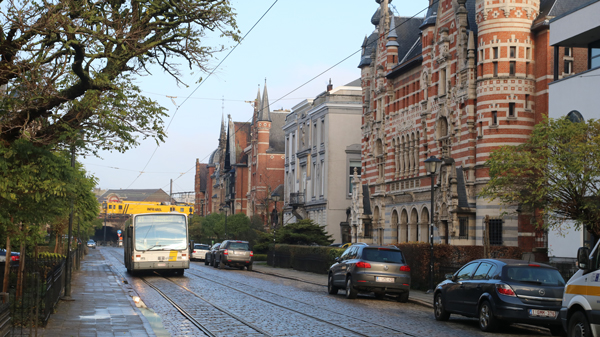 ere
are kosher bakers, butchers and restaurants. Of course also synagogues and
thoracic schools. In the 19th century, Antwerp Jews came to Antwerp from
Eastern Europe on the run for pogroms and persecution. The community grew
from 100 people to 40,000 at the beginning of the Second World War. We
continue to the Zurenborg district. At the end of the 19th century, the
Société Anonyme pour la Construction de Maisons Bourgeoises (Limited
Liability Company for the Construction of Civic Houses) developed a planned
residential area for the well-to-do bourgeoisie who fled the overcrowded
city centre on the lands of Baron Osy. The neighborhood is set up around
star-shaped squares and is full of Art Nouveau architecture. The central
square is the Dageraadplein, where many terraces and café’s can be found.
From there we walk via the Draakstraat to the Draakplein, the hub
ere
are kosher bakers, butchers and restaurants. Of course also synagogues and
thoracic schools. In the 19th century, Antwerp Jews came to Antwerp from
Eastern Europe on the run for pogroms and persecution. The community grew
from 100 people to 40,000 at the beginning of the Second World War. We
continue to the Zurenborg district. At the end of the 19th century, the
Société Anonyme pour la Construction de Maisons Bourgeoises (Limited
Liability Company for the Construction of Civic Houses) developed a planned
residential area for the well-to-do bourgeoisie who fled the overcrowded
city centre on the lands of Baron Osy. The neighborhood is set up around
star-shaped squares and is full of Art Nouveau architecture. The central
square is the Dageraadplein, where many terraces and café’s can be found.
From there we walk via the Draakstraat to the Draakplein, the hub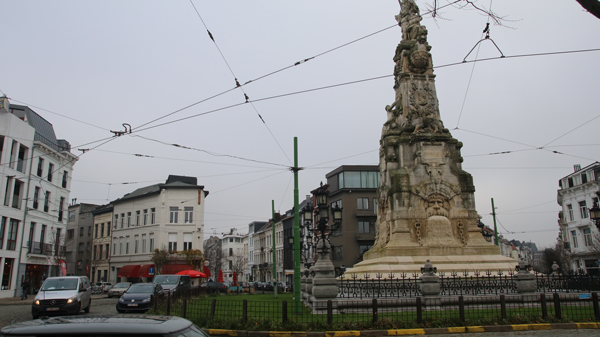 of the LGBT community of Antwerp with Cafe Den Draak and the Pink House. We
pass under the railway line and arrive in the other half of Zurenborg. This
part has been developed for the rich citizens. Almost exclusively city
villas and palaces with exuberant designs. The Cogels-Osylaan is the central
axis in this area. We drink coffee in the Wattman (an old name for tram
driver) near the former tram depot.
of the LGBT community of Antwerp with Cafe Den Draak and the Pink House. We
pass under the railway line and arrive in the other half of Zurenborg. This
part has been developed for the rich citizens. Almost exclusively city
villas and palaces with exuberant designs. The Cogels-Osylaan is the central
axis in this area. We drink coffee in the Wattman (an old name for tram
driver) near the former tram depot.
Then we take the bus to Het Zuid. The South was also developed at the end
of the 19th century on the land where the citadel or the Zuidkasteel of
Antwerp used to be. This castle was built between 1568-72 by order of the
Duke of Alva, but was demolished in the 19th century. The Royal Museum of
Fine Arts of Antwerp is centrally located in Het Zuid. The building was
completed in 1890 as a new building for the museum that used to be located
in the Academy. That building was susceptible to fire in the adjacent
buildings and that is why the separate building was designed as one of the
first buildings in the world that was specifically designed as a museum. The
museum has been closed for refurbishment since 2011 and will open again in
2019. Het Zuid also has star-shaped squares and wide boulevards that connect
these squares. On these squares are monuments that commemorate events in
Antwerp's history, such as the monument to the termination of the toll on
the Scheldt in 1863 at the Marnixplaats. Behind the museum we see a modern
statue of William the Taciturn and Marnix van Sint Aldegonde (the founding
fathers of the Dutch Republic in the 16th century) with memorial plaques for
events of the 80-year war against Spain. During this war Antwerp was
reconquered by the Span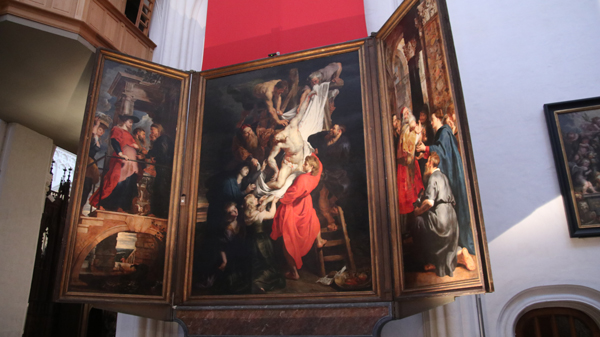 ish
and was thus prevented from joining the independent Dutch Republic. Also in
this district are beautiful Art Nouveau buildings.
ish
and was thus prevented from joining the independent Dutch Republic. Also in
this district are beautiful Art Nouveau buildings.
We walk with Erwin to the Institute of Tropical Medicine where our tour
ends. We have lunch in a brasserie on the Volksstraat, after which we take
the tram to the B & B. After a break, we walk to the banks of the Scheldt
and look out over the shipping quarters. Afterwards we drink a beer in Cafe
den Engel on the Grote Markt. After the beer we walk to the
Onze Lieve Vrouwen Cathedral.
This church dates largely from the 15th century. The tower dominates the
entire city. Because of the temporary closure of the museum for Fine Arts, a
number of works from the museum have been exhibited here. They are
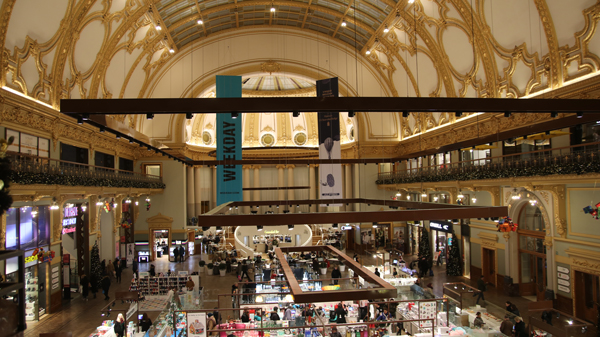 mainly
works that were made especially for the church. The permanent collection of
the church includes the Descent from the Cross by Rubens from 1612. The
altarpiece with the Assumption of Mary by Rubens is also a permanently here.
Finally, we go shopping at the Meir at Galleria Inno,
the large Belgian department store and in the Stadsfeestzaal. The
Stadsfeestzaalwas
built in 1908 as an exhibition and party hall, but burnt down almost
completely in 2000. In 2007, the building was reopened as a luxury shopping
centre, where several monumental parts have been rebuilt. We drink another
Kriek and 'nun Bolleke (Konink) in
De
Kroeg pub, across from our B & B, after which we have dinner at
Le Zoute Zoen. Great
restaurant with a tasty menu for 37 euros.
mainly
works that were made especially for the church. The permanent collection of
the church includes the Descent from the Cross by Rubens from 1612. The
altarpiece with the Assumption of Mary by Rubens is also a permanently here.
Finally, we go shopping at the Meir at Galleria Inno,
the large Belgian department store and in the Stadsfeestzaal. The
Stadsfeestzaalwas
built in 1908 as an exhibition and party hall, but burnt down almost
completely in 2000. In 2007, the building was reopened as a luxury shopping
centre, where several monumental parts have been rebuilt. We drink another
Kriek and 'nun Bolleke (Konink) in
De
Kroeg pub, across from our B & B, after which we have dinner at
Le Zoute Zoen. Great
restaurant with a tasty menu for 37 euros.
Weather: cloudy with sunny periods. 4 degrees.
Saturday, December 2, 2017
After breakfast we take the tram to the station. There we drink coffee at Starbucks before we take the Thalys at 10.30 to Rotterdam. At 11 o'clock we are in Rotterdam and take a ride home with Uber.
Weather: foggy, 6 degrees
read Other Travel